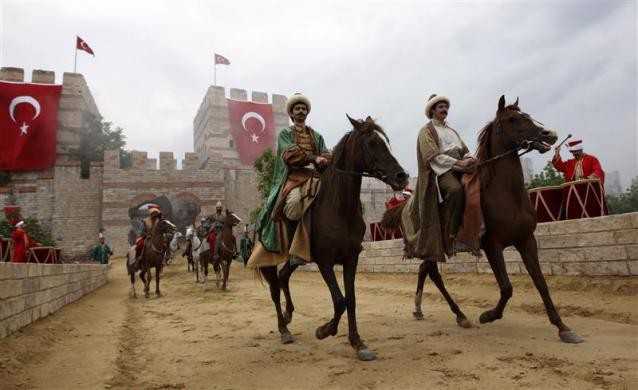O. Papadopol answers the question on Quora:
Yes, Turkey does recognize its Ottoman past but through the interpretation of Ziya Gökalp who was a moderate Ottoman Turkish nationalist of the last decades of the Ottoman Empire. To make it clear, in the last decades of the Ottoman Empire, various definitions of what Ottoman identity means were competing among the Ottoman elite:
- Ottomanism as meaning one Ottoman nation regardless of religion and language with all being equally Ottomans. Supporters of such ideology were Sultan Abdul Aziz, Ali Kemal Bey, Demat Ferid Pasha, Patriarch Sophronius III, Dimitrios Nikolaidis, Nikola Genovitch, etc ). They opted for a Brittish model of a political union of various nations, federalism, linguistic and religious equality and pluralism. Their political party was the centrist Freedom and Accord Party. They were very beloved by the Albanians and Armenians and others. Dimitrios Nikolaidis saw Mehmet II as a Greek and legitimate Byzantine Emperor. Many of these names are fallen into obscurity. There are very hard to find sources on the believers in Ottomanism simply because its supporters are not considered national heroes by any of the modern states. On the contrary, they are hated by the Greek, Turkish, Bulgarian, Albanian, Romanian, Arab, and other ex-Ottoman states for supporting Ottomanism instead of their respective nationalist ideologies.
- Sunni pan-Islamism as meaning that it defined Islam as the core of Ottoman identity. This ideology was supported by sultan Abdul Hamid II. It pushed for a centralized caliphate. It was hated by everybody except sunni kurds. Nationalist Turks hated it because it favoured Islam alone neglecting the Turkish aspect. It was hated by Arab Islamist nationalists (e.g. Abderrahman al-Kawakibi) because it neglected the Arab aspect. It was hated by Armenians because it neglected the Christian aspect.
- Mild Pan-Turkism combined with Islam difines being Ottoman as all religious and linguistic groups of the Ottomam Empire but still Sunni Turks are the “purest” of Ottomans. Supporter of such view is Midhat Pasha.
- Moderate Pan-Turkism combined with humanist Islam defining being Ottoman as mainly of Turkish race and sunni religion, but tolerating other languages and religions as “foreign” minorities. Supporters of such ideology were Mustafa Kemal, Ziya Gökalp, and Mahmud Shevket Pasha. Their political party was the short lived Felah-i Vatan. Unlike Islamists like sultan Abdluhamid II from n° 2, for the moderate and also the radical pan-Turkists (the latter which I explain below at n° 5), the importance of islam was seen not from a religious point of view but rather from a humanist secularist point of view as a means of unifying socially the Turkish nation. An exceptional supporter of such ideology was Pavlos Karahisarithis. He was a Turkish Christian Orthodox nationalist of the Karamanlides community. He and his Turkish nationalist Christian Orthodox karamanlides were excempt from the population exchange of 1923 due to their anti-Greek ideology and loyalty to Kemalism.
- Radical pan-Turkists combined with humanist Islam difining being Ottoman as of Turkish race and sunni religion just as the moderate ones but pushing for total and complete Turkification and annihillation of any religious or linguistic minority. Such supporters were Enver Pasha and Talat Pasha. Both the moderate and extremist pan-Turkists were inspired by the French model of state, with a very centralized government and linguistic and national uniformity with recognition of no religious or linguiistic minority whatsoever. That is, they invisioned a purely Muslim and Turkish speaking Ottoman state. It’s just tyat the radical extremists were willing to make much less compromise than the moderate ones. Their party was the Comitee of Union and Progess. Yakub Cemil young turk radical, assassinated Hüsein Nazim Pasha in the 1913 coup d’etat making pan-Turkic sunni nationalism as the one and only ideology of the state as all other ideologies and political parties were supressed. Basically this last one is the Turkish version of the Greek Megali Idea. The Megali Idea was pushing for an equal empire, occupying the same geographical space as the one invisioned by the Turkish pan-Turkists but instead of being purely Turkish and Muslim, to be purely Greek and Christian. Thus Greek Megali Idea and the radical pan-Turkists are the negative of eachother, different sides of the same coin, wanting the same Empire but either purely Greek or purely Turkish respectively. The difference is that Turanist Turks succeeded in highjacking the Ottoman state from the inside becoming it through coup d’etat while the Greek nationalists were fighting the Ottoman state from the outside by separating from it and trying to annex it to their state.
To answer clearly to your question, Turkey recognizes its Ottoman past but not from n°1 and n° 2 perspective but rather from mostly the n°4 with some sympathy and appologetism towards n°5. This means that Turkey recognizes its Ottoman past but only as a Turkish Empire according to the Comitee of Union and Progress official historical narrative. It rejects the pan-Islamist and multi-cultural Ottomanist narratives of what the Ottoman past identity means from n° 1 and n° 2 perspectives.


Leave a Reply